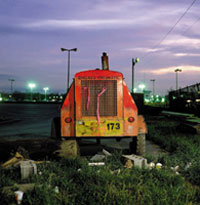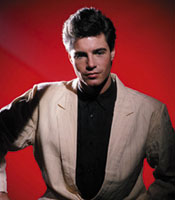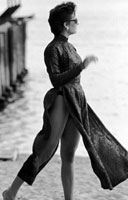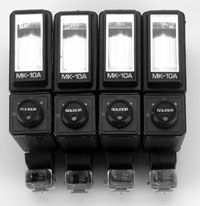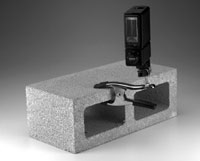The Simple Life
The Joys Of Shooting With Basic Gear
I love fancy photography equipment as much as the next guy, but there are times when I like to put away all of the expensive cameras, lighting gear, and softboxes and try and shoot with some basic gear. For many Shutterbug readers, our reviews of megabuck medium format cameras, studio flash units, and high-end lighting accessories are a trip to fantasyland. There's something to be said for those of you who devote countless hours to the craft of creating great images armed only with a Leica, a couple of lenses, and some creative energy. Even though I own a studio full of equipment, I like to strip it down every now and then. I'll often grab an old Ikoflex rollfilm TLR, a few rolls of T-Max, and a small handheld flash unit and go looking for great photo opportunities. While that basic outfit may be a bit restrictive for some, there are any number of ways to create great images without expensive equipment. In my own commercial work I often use some inexpensive solutions to problems that crop up. Here now are a few of my favorite simple shooting tips: |
|||
Hardware Store Lighting. Every photographer has had the same thought at the local hardware store: "Hey, those 500w utility lights would make pretty good studio lights!" Well, there's a reason why pros don't use those $15 lights for serious work. First of all, they're designed to be made cheaply, not to throw out a smooth, even pattern of light. Add to that the total lack of accessories like scrims and barn doors, and the inability to mount them in any sort of softbox. That said, you can't beat the amount of light you get for the money. When used with tungsten film you can get pretty decent results. Of course, these lights aren't carefully color balanced, so be prepared for close-but-no-cigar color balance. If you're looking to soften up the light produced by these bargain lights, be very careful. That piece of glass in the frame is not heat absorbing glass as found in video lights, it's just regular old picture glass. The amount of heat thrown off is formidable, and if you place the light head too close to a nylon or other diffusion panel you'll surely ignite it. |
|||
Flea Market Flash. Shoe mount flash units have come a long way. Modern computer controlled Thyristor units put out a lot of light exactly where you want it, and do it on autopilot. If you're not shooting on the run, you can string together a handful of "retro" flash units to produce a pretty exciting little lighting setup. I got into this a little while ago at a photo gear show in New York. I came across a vendor who had some flashes. Soligor? I remember wedding photographers in the 1970s using these things, but would I dare rely on something as odd as a used Soligor MK-10A? Well, why not? It's a big, beefy auto flash with tilt and swivel, full manual setting, and a port for an HV battery pack as well as PC synch. He had eight of them, and I bought them all. Once back in the studio I went through the units and managed to put together four completely functional flashes. I went online and ordered a bunch of brand-new Nexcell 1400m A Ni-MH batteries to keep the Soligors pumped up, and then put in an order for four Wein HS-XL slave units. The Ni-MH batteries are perfect for any older flash, because they'll give you rapid recycle, all-day performance and no memory. The Wein HS-XL are shoe mount versions of their XL-Series super slave wireless slave eyes. I've used Wein slaves for 15 years with nearly flawless results, and these things are a must have for any creative photographer. |
|||
Two days later I pulled out the little Soligors and turned them on, and they all worked perfectly. I shot about 60 medium format shots and the Soligors worked as expected. If you're just looking to jazz up your flash shots try this: buy some inexpensive flash units that have an "M" setting and order up slave eyes for them. When placed on light stands or clamped to door frames, experiment with different placements of the flashes in the foreground and background of your shot. Film is affordable enough to experiment with. If you shoot digitally, you cannot only get instant results, but really punch up the lame flash units in most modern digicams. The Manual Camera. If you read my lengthy review of the Ukrainian Kiev camera, you know that I really enjoyed working with those relatively basic manual cameras. I like to pull out my old Ikoflex TLR. Looking through the dim waist-level finder, holding the camera at chest level totally changes my perspective. While I like medium format
cameras, there's nothing wrong with a basic camera like a Nikon
F, an old Minolta SRT-101, or a Pentax Spotmatic. In fact, I own a dead
mint Pentax Spotmatic II in black finish with a nearly new 50mm f/1.4.
It's a solid, sweet handling camera with a surprisingly decent viewfinder.
|
|||
Putting Light Where You Need It. I often need to have a lot of little flashes around a set. For that I've settled on this simple and economical solution. I purchased a bunch of sturdy clamps at my local hardware store at the bargain hunter price of $1 each. An 83 cent bag of 1/4x20 screws with nuts helped me add standard screw threads to the handles of the clamps, and now I have 10 handy clamps for a grand total of $13! I not only use these for flash units, but to hold radio slaves, scrims, and reflectors, even the occasional camera. |
|||
The Normal Lens Blues. Though I bought my EOS-1 with the normal lens, I don't think I'd ever shot any film through it. Once the dust was blown off of the lens, I mounted it and vowed to shoot some film. My biggest surprise was how bright the finder was! I was used to thinking that an f/2.8 zoom lens was really "fast," so f/1.4 was a full two stops faster. Wow, what a difference. I found that the world looked a lot different. I always looked at 35mm as a format where I could use all of my photography tools to great effect. Wide or long I always went for a lens that made a statement. With a normal lens you're left to your own devices. The picture I shot with my plain old Ikoflex is a good example. With a bag full of gear I might not have noticed the bright orange Chicago Pneumatic thing in that parking lot at dusk. Perched on a couple of cinder blocks, I tripped the Ikoflex shutter set to "B" with a cable release, then walked a few feet away and fired my Vivitar flash on "M," then walked back and closed the shutter. I guess the exposure was around 4 sec or so at f/11. I kind of like this image. |
|||
It doesn't take a bagful of fancy photography gear to take good pictures. It also doesn't apply that stripping yourself down to the basics will create more picture opportunities. The bottom line is that if you have a vision you shouldn't let your lack of equipment stand in your way. Even if you own one of everything, sometimes it pays to put away the toys, grab some basic gear and go out to shoot some film. Try it yourself. |
- Log in or register to post comments
